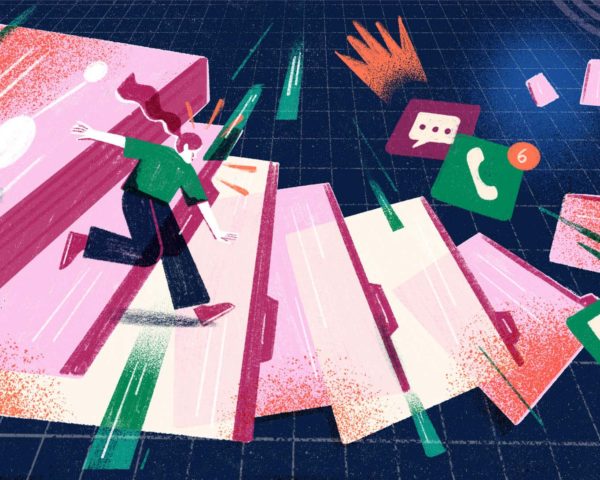How to get unstuck: tips for moving past analysis paralysis
Here’s what to do when you need to stop deliberating and start deciding.
Imagine you and your team need to decide how (and if) to respond to a recent negative customer review.
Somebody makes the case for leaving it unanswered. Another team member feels strongly that you should defend yourselves. Somebody else thinks you should keep it simple with a generic, “Thanks for your thoughts!” comment. Another person thinks you should have your senior leadership team respond.
You go around and around and you end up with plenty of choices, all of which have their pros and cons. But when you reconvene the next day, you’re not any closer to an actual decision. Instead, you kick off the whole cycle again — with everybody advocating for their ideas, or maybe even bringing entirely new ones to the table.
If anything, you’re further away from a final verdict than ever. Everybody’s fried and frustrated. Welp, your whole team just fell into the trap of analysis paralysis.
What causes analysis paralysis?
We typically point to overthinking as the root cause of relentless vacillation on a decision. You just keep churning and, even when you finally land on a solution or answer, you poke holes in it until you’re forced back to the drawing board.
Overthinking is a good bucket term for the culprits behind the phenomenon, but let’s break down the causes of analysis paralysis in a little more detail:
- Perfectionism: It’s harder to make a decision when you feel pressure (whether it’s self-imposed or not) to make the perfect choice. Research shows that perfectionism increases “paralysis of cognition and action,” especially when you’re facing uncertainty.
- Too many choices: It seems like a smart idea to uncover all potential options and avenues. However, too many alternatives actually make it harder to choose. Psychologist Barry Schwartz coined the term the “paradox of choice” to explain that an abundance of choices makes the decision-making process more difficult. In layperson’s terms, you’re saddled with information overload.
- Too much input: Similarly, a high degree of collaboration can fuel analysis paralysis too. When everybody gets to offer their opinion, you have more options, ideas, and people to weigh against each other when making a choice.
- Imposter syndrome: Analysis paralysis can also occur when you’re plagued with self-doubt and feel unqualified to make a decision. That sense of inadequacy makes you extra critical and indecisive.
The bad news about analysis paralysis
Most of us are taught to think carefully about the choices we make. When we swing too far in the other direction and make a rushed decision without enough consideration, it’s referred to as extinction by instinct.
So it seems a bit counterintuitive that you could think about a decision too much. But in reality, constant hemming and hawing can lead to a number of drawbacks. Here are a few common consequences of analysis paralysis:
- Slow decision-making: It’s nearly impossible to make quick or efficient decisions when you need to chew on every possible option. In many cases, decisions don’t just need to be good — they need to happen fast. Analysis paralysis will halt your decision-making (or at the very least, slow you down big time).
- Decreased performance: Decisions are mentally taxing, even when you make them quickly. Overthinking every choice and option makes decisions even more demanding, which can increase decision fatigue, sap your mental resources, and worsen your overall performance.
- Team frustration: Feeling permanently frozen in a state of indecision can breed annoyance and irritation on your team — particularly if they’re waiting for a direction or final choice to move forward with their own work. Unfortunately, only 48% of respondents in a McKinsey survey said that their organizations make decisions quickly.
- Limited creativity: The more you think about something, the more you limit yourself with restrictions and requirements. Research shows that too much overthinking diminishes your creativity. So, if you’re really trying to think outside the box, try for less analysis and more fortitude.
Make your choice: 5 tips to overcome analysis paralysis
Analysis paralysis is a pain, but it’s definitely common. Most of us struggle with solid, efficient decision-making.
In a recent survey, an alarming 85% of business leaders say they’ve suffered from decision distress in the past year, whether they regretted a decision, felt guilty about it, or looked back and questioned their choice.
Here are a few tactics you can put into play to minimize your (and your team’s) indecisiveness.
1. Make big decisions first
Some experts argue that we have limited capacity and energy for making decisions — that’s the idea behind decision fatigue. Every choice you make chips away at your mental resources until you have nothing left to give.
There’s some debate over whether or not your focus and willpower are actually finite resources. But just in case, this tip can be helpful: make your biggest, meatiest, most important decisions at the beginning of the day.
Early on, you won’t be so fried and worn out from the numerous other choices you have to make on a daily basis. So you’ll have a better chance of making a more sound and swift decision (with less back and forth).
2. Understand potential impacts
Not all decisions are created equal. Some — like who to hire or how to allocate the team’s budget effectively — warrant some thorough deliberation and discussion. Others — like whether everybody should use PowerPoint or Google Slides — don’t warrant that same level of scrutiny.
That’s why it’s helpful to think through the potential consequences of the decision your team is faced with. Try asking yourself something like this: What’s the worst-case scenario if we get this decision wrong?
That’s not meant to inspire fear, but rather to understand just how pertinent and pressing the choice is. If any conceivable fallout isn’t all that dire, you and the team have permission to let go of perfectionism and go with your gut.
3. Set a firm deadline
The decision-making process can quickly default to Parkinson’s Law — it’ll expand to fill the time you give it. One of the best ways to keep your timeline in check is by setting (and sticking to) a firm deadline for a decision.
Just be aware that, while deadlines amp up the urgency of decision-making, they can also decrease the quality of your choice if you aren’t careful. So don’t be too ambitious with the deadlines you set. You and your team still deserve a bit of time to deliberate, especially on meaningful and weighty decisions.
4. Limit your choices
When too many choices leads to analysis paralysis, reducing your options is another solid way to manage indecision — whether that means limiting the possible avenues you’ll explore, the amount of people you’ll involve in the conversation, or both.
Put simply, a simpler and more streamlined decision-making process manages your cognitive overload and translates to less time (and stress) spent turning over every stone.
It can be hard to keep your options in check — particularly for decisions that require a lot of brainstorming and limitless thinking. Try something called “thin-slicing,” where you look at all of the variables involved in your decision and zero in on the ones that matter most.
Let’s return to our opening example of a negative customer review for clarity. To start, your team is throwing out suggestions with reckless abandon. But when it’s time to actually make the decision, focus on the thin slice (meaning, the most important criteria) for your choice. Basically, what matters most to the majority of your team? Do you want to:
- Move on quickly?
- Defend your reputation?
- Preserve your brand?
- Take ownership?
That narrower filter makes it way easier to whittle down your options and make your choice, as opposed to trying to consider everything all at once. If you’re stuck on figuring out your criteria in the first place, a trade off analysis can help you and your team determine your priorities.
From (over)analyzing to action
There’s nothing inherently wrong with thinking carefully about an important decision. In many cases, some thorough consideration is the recommended approach.
The problems arise when you end up frozen in the stage of analyzing and deliberating — and you can’t seem to move forward and actually draw a final conclusion. That’s analysis paralysis, a common productivity-sapping occurrence among leaders and teams.
So the next time you’re plagued with indecision, think about implementing one (or all) of these strategies to go from stuck to swift decision. Just don’t think about it for too long, okay?













































